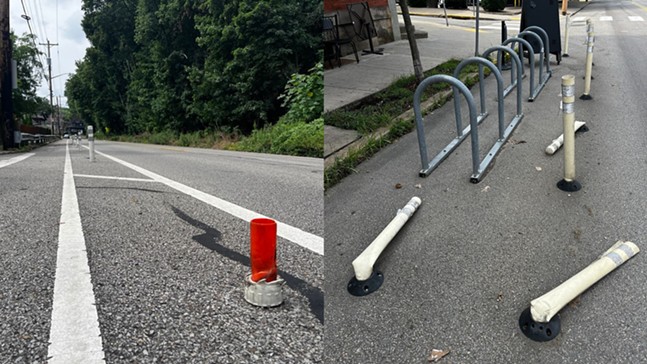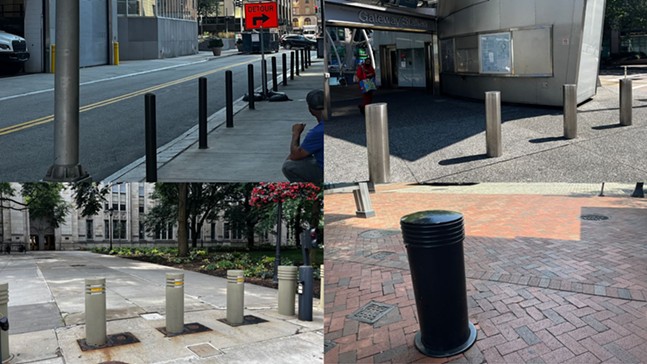Because of the latter, they do little for the former. Trucks can easily squash flexible barriers, making it easy for delivery drivers and aggressive shortcutters to overtake bike lanes with several tons of steel. While they’re a step up from mere lines and paint, these flimsy bits of plastic are a Band-Aid instead of surgery for the problem of making roads, sidewalks, and busy crossings safer for all users.
There is a better way: the Way of the Bollard.
So what is a bollard? Per Wikipedia, it is a “sturdy, short vertical post.” While often found where you can moor boats, they’ve become essential traffic-control tools when installed where you don’t want cars. They can be decorated, illuminated, removable, retractable. Often, they’re supported by a wide underground base that allows them to withstand many thousands of pounds of force.
The key difference between bollards and flex posts? I’m glad you asked:
Try getting into my bike lane now!
I’m sure at least one person reading this is going to get mad or accuse me of wishing drivers harm. On the contrary — even in the above scenario, a driver is likely to be relatively safe thanks to advancements in car safety. But a bollard ensures that even when a driver is unsafe, their vehicle cannot physically enter spaces designed for people and their bikes, skates, wheelchairs, scooters, and strollers.
We have plenty of bollards in Pittsburgh. Just downtown, you’ll find these silent sentinels guarding the perimeter of Market Square. Similar physical barriers protect the William S. Moorhead Federal Building and the entrance to Point State Park. (The Penn Ave. bike lane, though not protected by bollards, has nonetheless benefitted from the addition of concrete wheel stops between 11th and Stanwix). You’ll find still more along Fifth and Forbes in Oakland and elsewhere in town.
Flexposts may say “no thank you,” but bollards say “absolutely not.” Bollards are also a proactive “yes,” clearly signaling that a space is for any humans not wrapped in 3,000 pounds of metal and plastic.

CP Photo: Colin Williams
FlexPosts are often sheared off or squashed like these examples in Morningside and Lawrenceville.
The solution? Make drivers adapt. This is essentially the thesis of every Transit Talk I’ve written: making a city less convenient for fast drivers makes it safer for everyone else. More novel modes of transit such as water taxis and more intensive conversions such as roundabouts would lessen and calm traffic, respectively, but bollards are a cheap way to defend what you have.
Imagine never having cars intrude on your favorite bike lane or pedestrian plaza. Bollards could turn painted neckdowns (like the one recently completed on Woods Run Ave.) into permanent pedestrian zones or wide sidewalks into car-proof outdoor dining spaces. Similar to the Cultural District’s fanciful bike racks, bollards could be rolled out in the shape of baseball bats, blast furnaces, test tubes, or penguins depending on their location. Retractable bollards could also be used to turn some narrower streets into bus-only shortcuts or shopping plazas closed to all non-emergency vehicles. Why not use them to limit Penn Ave. to pedestrians, rollers, and cyclists full time?
At some point, you have to make driving inconvenient or impossible in parts of a city. Only then can a true multi-use future emerge. Bollards are among the most cost-effective ways to do this in the existing built environment, even if that means the occasional fender-bender or oil leak from an impatient driver. Meanwhile, there may be other traffic calming solutions hidden just beneath the surface of Pittsburgh’s roads…


